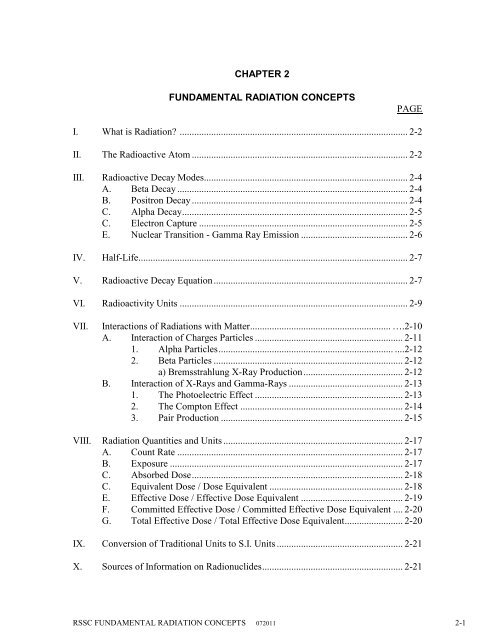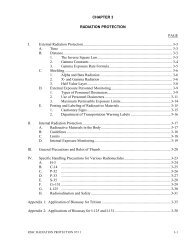CHAPTER 2 FUNDAMENTAL RADIATION CONCEPTS PAGE I ...
CHAPTER 2 FUNDAMENTAL RADIATION CONCEPTS PAGE I ...
CHAPTER 2 FUNDAMENTAL RADIATION CONCEPTS PAGE I ...
- No tags were found...
You also want an ePaper? Increase the reach of your titles
YUMPU automatically turns print PDFs into web optimized ePapers that Google loves.
<strong>CHAPTER</strong> 2<strong>FUNDAMENTAL</strong> <strong>RADIATION</strong> <strong>CONCEPTS</strong><strong>PAGE</strong>I. What is Radiation? .............................................................................................. 2-2II. The Radioactive Atom ......................................................................................... 2-2III. Radioactive Decay Modes.................................................................................... 2-4A. Beta Decay ............................................................................................... 2-4B. Positron Decay ......................................................................................... 2-4C. Alpha Decay ............................................................................................. 2-5C. Electron Capture ...................................................................................... 2-5E. Nuclear Transition - Gamma Ray Emission ............................................ 2-6IV. Half-Life ............................................................................................................... 2-7V. Radioactive Decay Equation ................................................................................ 2-7VI. Radioactivity Units .............................................................................................. 2-9VII.Interactions of Radiations with Matter .......................................................... ….2-10A. Interaction of Charges Particles ............................................................. 2-111. Alpha Particles ........................................................................ ....2-122. Beta Particles .............................................................................. 2-12a) Bremsstrahlung X-Ray Production ......................................... 2-12B. Interaction of X-Rays and Gamma-Rays ............................................... 2-131. The Photoelectric Effect ............................................................. 2-132. The Compton Effect ................................................................... 2-143. Pair Production ........................................................................... 2-15VIII. Radiation Quantities and Units .......................................................................... 2-17A. Count Rate ............................................................................................. 2-17B. Exposure ................................................................................................ 2-17C. Absorbed Dose ....................................................................................... 2-18C. Equivalent Dose / Dose Equivalent ....................................................... 2-18E. Effective Dose / Effective Dose Equivalent .......................................... 2-19F. Committed Effective Dose / Committed Effective Dose Equivalent .... 2-20G. Total Effective Dose / Total Effective Dose Equivalent ........................ 2-20IX. Conversion of Traditional Units to S.I. Units .................................................... 2-21X. Sources of Information on Radionuclides .......................................................... 2-21RSSC <strong>FUNDAMENTAL</strong> <strong>RADIATION</strong> <strong>CONCEPTS</strong> 072011 2-1
<strong>FUNDAMENTAL</strong> <strong>RADIATION</strong> <strong>CONCEPTS</strong>I. WHAT IS <strong>RADIATION</strong>?Radiation is defined as energy that travels through space or matter in the form of aparticle or wave. It can be produced in one of two ways: by radioactive decay of anunstable atom (radionuclide), or by the interaction of a particle with matter. Someattributes of radioactive decay are that it is spontaneous and random, and the type ofradiation emitted depends on the specific radionuclide. Radiation emission as the result ofan interaction, on the other hand, depends on both the incoming particle and the materialit hits, and is theoretically predictable if enough information is known. (In reality, it isimpossible to obtain enough information to make predictions about radiation emissionfrom a single incoming particle, but it is possible to make statistical predictions aboutlarge numbers of particles.) Radioactive decay and interactions will be discussed in moredetail in the following sections.Radiation is described by its type and energy. The types of radiation fall into two maincategories: particulate and electromagnetic. Particulate radiation consists of particles thathave mass and energy, and may or may not have an electric charge. Examples ofparticulate radiation include alpha particles, protons, beta particles, and neutrons.Electromagnetic radiation, on the other hand, consists of photons that have energy, but nomass or charge. A photon, as described by quantum theory, is a "particle" or "quantum"that contains a discrete quantity of electromagnetic energy which travels at the speed oflight, or 3 x 10 8 meters per second. A photon is sometimes described as a “packet oflight”. Visible light, ultraviolet light, x-rays, and gamma rays are all photons.The most common unit of energy used to describe radiation is the electronvolt (eV). Anelectronvolt is the amount of kinetic energy an electron gains when accelerated through apotential difference of one volt. The conversion to SI units is 1 eV = 1.6x10 -19 joules. AneV is a very small unit of energy, so in many applications, it is more common to use kiloelectronvolts(1 keV = 1000 eV) or mega-electronvolts (1 MeV = 1,000,000 eV).Radiation can be either ionizing or non-ionizing, depending on its energy and ability topenetrate matter. Non-ionizing radiation, such as visible light, is not harmful. Onlyionizing radiation is discussed in this course. Ionization is discussed in more detail onpage 11.II.THE RADIOACTIVE ATOMAll matter is composed of atoms. The atom contains a nucleus, consisting of protons andneutrons, with electrons revolving in orbits about the nucleus. Electrons carry a negativecharge, protons carry a positive charge, and neutrons have no electrical charge. An atomnormally has one electron in orbit for each proton in the nucleus, leaving the atom2-2 RSSC <strong>FUNDAMENTAL</strong> <strong>RADIATION</strong> <strong>CONCEPTS</strong> 072011
electrically neutral. An element is a type of atom distinguished by its number of protons(e.g. an atom of the element hydrogen always has one proton; an atom of the elementhelium always has two protons, etc).The atomic structure of an element is denoted asA ZXwhere: Xis the chemical symbol of the element.ZAis the atomic number, defined as the number of protons in the nucleus. Thisdetermines the chemical identity of the element.is the mass number, defined as the sum of the number of protons and neutrons inthe nucleus. Thus, A minus Z gives the number of neutrons. An element mayhave different numbers of neutrons and still be chemically the same.Each individual arrangement of protons and neutrons is referred to as a nuclide. Nuclideswhich have the same number of protons are called isotopes. Shown below are examplesof isotopes of hydrogen:1231H Hydrogen1H Deuterium1H TritiumMany nuclides (but not all) are unstable or "radioactive". In the above example ofnuclides, only tritium is radioactive. Radioactivity is defined as the spontaneousdisintegration of unstable nuclei, with the resulting emission of radiation that results inthe formation of new nuclei. Stability of the nucleus is related to its ratio of neutrons toprotons. For low atomic number elements, approximately equal numbers of neutrons andprotons in the nucleus are necessary for stability. For elements of higher atomic number,the ratio rises to approximately 1.6 to 1. As a nuclide departs from this stable ratio,changes in the nucleus occur which tend to bring the product to a more stablearrangement. This approach to stability is accomplished by one or more of five (5)"radioactive decay modes".RSSC <strong>FUNDAMENTAL</strong> <strong>RADIATION</strong> <strong>CONCEPTS</strong> 072011 2-3
III.RADIOACTIVE DECAY MODESA. Beta Minus DecayWhen the neutron to proton ratio is too high, a neutron "transforms" into a protonand electron, with the electron being ejected from the nucleus. The ejectedelectron is called a “beta minus particle” or just "beta particle". Beta particles arenot emitted with a single energy but are emitted with a spectrum of energies up tosome maximum value. This is due to a division of the total energy of eachdisintegration between the beta particle and a neutrino, which is another particlethat is emitted at the same time as the beta particle. The neutrino has a negligiblysmall mass and no charge, and it carries off varying amounts of the releasedenergy. It therefore travels great distances, losing little energy in nearby materialsand causing no biological damage.The energy of the ejected beta particle is characteristic of each nuclide and is onecriterion used for identification purposes. In general, the average particle energyis about 1/3 of the maximum possible energy.The generalized atomic equation for beta decay is as follows:AX A YZ Z 1 X = original (parent) atomY = new (daughter) atomß - = beta particle (electron) = neutrinoExamples of Beta decay:3 31H 2He0.0186 MeV MeV = mega electronvolts= 1 million electron volts14 146C 7N 0. 156 MeV maximum beta particle energyNote that the term “beta minus decay” is often simplified to “beta decay.”B. Positron/Beta Plus DecayWhen the neutron to proton ratio is too low, a proton transforms into a neutronand a positron (beta plus particle), and the positron is ejected from the atom. Apositron has a positive charge and the same mass as an electron. The positronbehaves exactly as an electron except that when the positron comes in contactwith a free electron, the two particles combine and are annihilated. This gives riseto two photons whose energies correspond to the rest mass equivalence of the2-4 RSSC <strong>FUNDAMENTAL</strong> <strong>RADIATION</strong> <strong>CONCEPTS</strong> 072011
particles (0.511 MeV/photon). See page 16 for a description of annihilationradiation. Like beta minus decay, the energy released in the decay is split betweenthe positron and a neutrino, so positrons are emitted with a spectrum of energies.The generalized atomic equation for positron decay is as follows:AX A Y Z Z 1 positron(beta plus particle)Examples of Positron decay:191019NeF 2. 22 Mev 9221122Na Ne 0. 544 Mev 10C. Alpha DecayAlpha decay occurs for those nuclides which have an atomic number greater than82. Such heavy nuclides have no stable configuration of neutrons and protons,and as a result, emit an alpha particle consisting of 2 protons and 2 neutrons.Generally, a series of alpha (as well as beta) decays are required until a lighter,stable element is reached. Unlike beta particles, alpha particles are emitted with adiscrete energy.The generalized atomic equation for alpha decay is:AZX A 4Y Z 2 alpha particleAn alpha particle is identical to a helium nucleus, so it is sometimes written2He instead of .42Examples of alpha decay:206Po Pb 5. 3 MeV 21084 82218Rn Po 5. 59 MeV 22286 84D. Electron CaptureIn this decay mode, one of the orbital electrons is captured by the nucleus andcombines with a proton to form a neutron. Electron capture competes withpositron decay when there is a low neutron to proton ratio. If the atom is unableto meet the energy requirements of positron decay, then decay occurs by electronRSSC <strong>FUNDAMENTAL</strong> <strong>RADIATION</strong> <strong>CONCEPTS</strong> 072011 2-5
capture. Whenever an atom decays by electron capture, x-rays are emitted that arecharacteristic of the newly formed nuclide. No particles are emitted duringelectron capture decay.The generalized atomic equation for electron capture is:X o A1eZ Y x rays e = electronAZ 1Examples of electron capture decay:5425Mno 1e5424Cr 0.835 MeVx rays 12553Io 1e12552Te 0.035 MeVx rays E. Nuclear/Isomeric TransitionWhen the emission of a particle leaves the product nucleus in a partially excited or"metastable" state (designated with an “m” after the mass number), gamma raysare emitted. The gamma rays carry away the excess energy of the partially excitednucleus after a decay event. Such gamma rays are of a discrete energy and arecharacteristic of the particular nuclide involved, so they can be used foridentification purposes. No particles are emitted, and the nucleus does not changeatomic number.The generalized atomic equation for nuclear transition is:AZX ZX = gamma rayAmExamples of radionuclides that undergo nuclear transition are shown below. Notethat nuclear transition can occur after beta decay, positron decay, alpha decay, orelectron capture:60 60m 6027Co28Ni 0.318 MeV 28N 1.17 MeV 1.33MeV22 22m 2211Na10Ne 0.543 MeV 10Ne 1.27 MeV 222m22288Ra86Rn 4.47 MeV 4.59MeV 86Rn226125m12553I52Te x rays 52Te1250.035 MeV 0.186MeV2-6 RSSC <strong>FUNDAMENTAL</strong> <strong>RADIATION</strong> <strong>CONCEPTS</strong> 072011
The Chart of the Nuclides lists all known nuclides and is a useful reference forradioactive decay and energy data (see page 21 for information on obtaining theChart of the Nuclides).IV.HALF-LIFEThe half-life of a radioactive substance is the time it takes for half of the atoms toundergo radioactive decay. It can also be defined as the time it takes for the activity of asample to decrease by half (see section VI). The number of atoms remaining after n halflivesis equal to:NN0 where Nn0 = initial number of atoms.2Thus, for n = 1, 1/2 of the initial atoms remain; for n = 2, 1/4 remain; for n = 3, 1/8remain, and so on.V. THE RADIOACTIVE DECAY EQUATIONA radioactive nuclide disintegrates or decays spontaneously at a rate depending on thenumber of original atoms present and upon its decay constant, lambda (). The constant is defined as the instantaneous fraction of atoms decaying per unit time. Eachradioactive nuclide has its own characteristic decay constant.The instantaneous time rate of change of the number of atoms, N, for a radionuclide isgiven by:dN NdtIf we started with N 0 radioactive atoms at some time t = 0, the number of atoms present atsome other time N t can be obtained by integrating:dN dtNNtNodNNto dt1 n Nt tN o RSSC <strong>FUNDAMENTAL</strong> <strong>RADIATION</strong> <strong>CONCEPTS</strong> 072011 2-7
Number of atomsNNto etNtNoetNOTE - the decay time and half-life must be in the same units of time.The e -t term indicates that the radioactive atoms decay exponentially. This equation,N t = N o e -t , is called the decay equation. The figure below plots the decay equation forP-32, which has a decay constant of 0.049 1 / day , starting from one million atoms. Thenumbers on the y-axis would change depending on the initial number of atoms, and thenumber on the x-axis would change depending on the radionuclide, but the overall shapeof the curve is the same for all radionuclides.Radioactive Decay of P-32100000090000080000070000060000050000040000030000020000010000000 20 40 60 80 100 120 140 160Time (days)If we were to substitute into the decay equation the time, T 1/2 , it takes for the reduction ofa quantity of radioactive atoms to half of the original, we get:1NT 2N oN Ne1 T1 / 22 o oe 1 T1 / 2212 1/ 221n1 T 1n1n 22-8 RSSC <strong>FUNDAMENTAL</strong> <strong>RADIATION</strong> <strong>CONCEPTS</strong> 072011
1n2T1/ 2ln 2T1/2 ln 2 0.693 0.693T1/ 2Thus, the decay constant () can be calculated for any radioactive nuclide from its halflife.VI.RADIOACTIVITY UNITSThe number of atoms, N, remaining at a particular instant in time is given by:A = Nwhere A is the activity, defined as the instantaneous number of atoms decaying per unittime. The activity is directly determined by the quantity of radioactive material in asample, and is generally a much more convenient quantity to use than the number ofradioactive atoms. The traditional unit for activity is called the curie (Ci).1 curie = 3.7 x 10 10 disintegrations per second (dps)OR1 curie = 2.22 x 10 12 disintegrations per minute (dpm)Because the curie is a very large quantity, fractions of the curie are often used:1 millicurie = (mCi) = 2.22 x 10 9 dpm = 10 -3 curies1 microcurie = (Ci) = 2.22 x 10 6 dpm = 10 -6 curies1 nanocurie = (nCi) = 2.22 x 10 3 dpm = 10 -9 curies1 picocurie = (pCi) = 2.22 dpm = 10 -12 curiesSince radioactive material is measured in units of activity, the decay equation now takesthe form:A = A o e -tRSSC <strong>FUNDAMENTAL</strong> <strong>RADIATION</strong> <strong>CONCEPTS</strong> 072011 2-9
Where:A = Activity after some time tA o = Original activity of the sample = The radioactive decay constant equal tot = Decay time0.693T1/ 2The half-life equation (section V) can be also used for activity, simply by replacing thenumber of atoms N and N 0 with the activities A and A 0 .It should be mentioned that the International System (SI) of units has defined thebecquerel (Bq) as the unit of activity, equal to 1 disintegration per second. Thus:1 Ci = 3.7 x 10 10 Bq.The becquerel is already in use in most parts of the world and in most modern scientificliterature. The curie is still in common use in the United States, although it is expectedthat the becquerel will eventually replace the curie.Specific activity refers to the amount of radioactivity per given mass or other similar unitsof the sample. Specific activity is usually expressed in terms of the disintegration rate(dps or dpm), or count rate (counts/min, cpm, or counts/sec, cps), or curies (or mCi, Ci)of the specific radionuclide per unit mass of the element. Therefore:236.0210SA N Bq gm236.0210where SA = specific activity, = decay constant, N number of atoms ,mand m = molecular mass (grams/mole). Note that the units in this case are Bq/g (dps/g).VII.INTERACTIONS OF <strong>RADIATION</strong> WITH MATTERRadiation interacting with matter can be either scattered or absorbed. The mechanisms ofthe absorption of radiation are of interest because: a) absorption in the body tissues mayresult in biological injury; b) absorption is the principle upon which detection ofradiation is based; c) the degree of absorption is the primary factor in determining propershielding requirements.The transfer of energy from emitted radiations to matter occurs in two major ways:ionization and excitation.2-10 RSSC <strong>FUNDAMENTAL</strong> <strong>RADIATION</strong> <strong>CONCEPTS</strong> 072011
Ionization:Excitation:The process resulting in the removal of an electron from an atom,leaving the atom with a net positive charge.Addition of energy to an atomic system, transferring it from theground state to an excited state. No ion pair is formed, but energyis then given off by the atom as fluorescent radiation or low energyx-rays when the atom returns to its ground state.Radiation can be classified into two groups:1) Particulate radiation such as alpha and beta particles2) Electromagnetic radiation such as x-rays or gamma rays.Particulate radiation can be either charged (alpha or beta particles) or uncharged(neutrons); however, only charged particle interactions will be discussed here.A. Interactions of Charged ParticlesAll atoms are normally electrically neutral. When a charged particle strikes anorbital electron it ejects it from the atom, resulting in the formation of an ion pair.Since the removal of the electron from the atom decreases the total number ofnegative charges by one, it leaves the atom with a net positive charge. The ionpair consists of:1) The positively charged atom2) The negatively charged electronSuch particles capable of creating ion pairs in this manner are called ionizingradiation.The term used to compare and relate the ionizing powers of different types ofcharged particles is specific ionization. Specific ionization is defined as thenumber of ion pairs per unit path length formed by ionizing radiation in amedium:# of ion pairs formedSpecific ionization =path length (cm)The specific ionization is dependent on the velocity and mass of the chargedparticle (and therefore its energy), the charge of the particle, and the density of theabsorbing material (the number of atoms available for ionization).The most common types of charged particles encountered in most applications arealpha particles and beta particles. Their particular interactions are described inmore detail below.RSSC <strong>FUNDAMENTAL</strong> <strong>RADIATION</strong> <strong>CONCEPTS</strong> 072011 2-11
1. Alpha ParticlesAn alpha particle is a helium nucleus stripped of its orbital electrons. It isemitted from a radioactive atom with a velocity of about 1/20 that of thespeed of light and with energies ranging from 4 to 9 MeV. Alphas causeionizations in matter when they are deflected by the positive charge of anucleus and pull the orbital electrons (attracted by the alpha's positivecharge) along with them. Alpha particles also cause excitation along theirpath by pulling inner orbital electrons to outer orbits. Energy is then givenoff by the atom as fluorescent radiation (low energy x-rays) when theelectrons drop back down to the inner orbital vacancies.Because of its relatively large mass (2 neutrons and 2 protons), highelectrical charge (2+) and low velocity, the specific ionization of an alphaparticle is very high. That is, it creates many ion pairs in a very short pathlength. Because of this, it loses all of its energy in a very short distance.The range in air is only several centimeters even for the most energeticalpha particles.Since the alpha particle has a very limited range in matter, it presents noexternal radiation hazard to man. Many alpha particles cannot penetratethe protective layer of skin. However, once inside the body, surrounded byliving tissue, damage will be to the local area in which the alpha emitter isdeposited. Thus, alpha emitters are an internal hazard and intake to thebody must be prevented.2. Beta ParticlesBeta particles are emitted from the nucleus of a radioactive atom with awide range of energies up to some maximum value. When a beta isemitted that is below the maximum value, the neutrino carries away therest of the energy.Beta particles, like alpha particles, lose their energy by ionization andexcitation, but because of their small mass (1/7300 of an alpha) and lowercharge (1/2 of that of an alpha) the interactions take place at less frequentintervals. Therefore, the beta particles do not produce as many ion pairsper centimeter of path as alpha particles, and thus, have a greater range inmatter. The beta particle's range in matter depends on its energy and thecomposition of the material.a) Bremsstrahlung X-ray Production:Beta particles can interact with the nucleus of an atom and give riseto x-rays by a method called Bremsstrahlung. Bremsstrahlung(German for "Braking Radiation") occurs when a high-speed beta2-12 RSSC <strong>FUNDAMENTAL</strong> <strong>RADIATION</strong> <strong>CONCEPTS</strong> 072011
particle approaches the nucleus of an atom. The electrical interactionbetween the negative beta particle and the positively charged nucleuscauses the beta particle to be deflected from its original path or stoppedaltogether. This stoppage or deflection results in a change in velocity, ordeceleration, of the beta particle with the emission of x-rays of variousenergies. The likelihood of Bremsstrahlung production increases withincreasing atomic number of the absorber. For this reason, beta shields aremade from low atomic number materials, like aluminum or plastics, toreduce Bremsstrahlung production. X-ray tubes are made with high atomicnumber materials, to encourage Bremsstrahlung production.Beta particles require an energy of greater than 70 keV to penetrate theprotective layer of the skin, and thus, are somewhat of an external hazard.The beta can also constitute an internal hazard. A beta particle has agreater range in tissue compared to an alpha particle due to its low specificionization, therefore, it gives up less energy per unit volume of tissue andis not as effective in causing damage as an alpha particle.B. Interaction of X-Rays and Gamma RaysFrom a practical radiation protection point of view, x-rays and gamma rays areidentical, differing only in their place of origin. Gamma rays are emitted withdiscrete energies from excited nuclei. X-rays are emitted from outside thenucleus; i.e., an outer shell electron replaces a missing lower shell electron and acharacteristic x-ray is produced, or the interaction of beta particles causesBremsstrahlung radiation to be produced. The energy of a characteristic x-ray isapproximately equal to the difference in the electron energy levels, butBremsstrahlung radiation produces a continuous spectrum of energies up to somemaximum value.Since x- and rays are chargeless, they do not interact by electrostatic forces as inthe case of charged particles, which cause ionization of matter directly along theirpath of travel. However, x- and gamma rays do have sufficient energy to releasesecondary charged particles (electrons) from matter through one of three basicinteractions: the Photoelectric Effect, the Compton Effect, and Pair Production.The high-speed electrons resulting from these interactions then cause ionization ofthe medium.1. The Photoelectric EffectThe Photoelectric Effect is the interaction of x- or -ray photons as well as otherphotons (such as light), whereby all of the energy of the photon is transferred to aninner shell electron (usually the K shell), ejecting it from the atom and leaving theatom with an inner shell vacancy. This shell vacancy creates an excitation energywhich corresponds to the binding energy (BE) of the ejected photoelectron.RSSC <strong>FUNDAMENTAL</strong> <strong>RADIATION</strong> <strong>CONCEPTS</strong> 072011 2-13
The kinetic energy (KE) of the photoelectron is equal to the energy of thex- or -ray photon minus the BE of the electron ejected:KE photoelectron = E x- or E - BE of electronIf the x- or photon does not have sufficient energy to knock the innershell electron loose, the reaction will not occur.The resultant atom is now in an excited state and will decay to the groundstate by emission of x-rays and fluorescent radiation. The energies of thesecondary radiations are usually much lower than the primary x- or -rayenergies.Application of the Photoelectric EffectGamma rays emitted from excited nuclei, and x-rays emitted from excitedatoms, have discrete energy characteristics of the specific nuclides andelements, respectively. Thus, the energy of these or x- photons can beused as "finger prints" to identify nuclides and elements. The photoelectriceffect is also the means by which photons are absorbed by shieldingmaterials and radiation detectors.2. The Compton Effect (named after A. H. Compton)Photons with energies much greater than the BE of the electrons in anatom may interact through scattering interactions in which the total KE ofthe system is conserved. In this interaction, the electron appears to thephoton as a free electron (BE = 0).2-14 RSSC <strong>FUNDAMENTAL</strong> <strong>RADIATION</strong> <strong>CONCEPTS</strong> 072011
The primary loses part of its energy to the Compton electron which getsscattered at an angle from the original direction of the incident , whilethe Compton scattered (') is scattered at an angle (see diagram). Inthis process the scattered photon and Compton electron share the energy ofthe incident photon ().The KE carried off by the Compton electron may be deposited locally (i.e.,absorbed immediately by the surroundings). However, the energy carriedoff by the Compton scattered photon is not deposited locally. Therefore,this scattered photon can significantly contribute to the dose outside ashielding apparatus.Application of the Compton EffectDue to its characteristic peaks, the Compton effect aids in theidentification of unknown nuclides. However, in a detecting system, theCompton scattered electron can mask lower energy photons interacting bythe photoelectric effect, making interpretation of results difficult.3. Pair ProductionHigh-energy gamma photons transfer their energy primarily by pairproduction. A high-energy x- or -ray passing close to a nucleus suddenlydisappears and an electron and a positron appear in its place. Thisinteraction must take place in an electric field, usually that of the nucleus,in order to conserve momentum.RSSC <strong>FUNDAMENTAL</strong> <strong>RADIATION</strong> <strong>CONCEPTS</strong> 072011 2-15
Since both particles are created from energy supplied by the incidentphoton, the process is energetically possible only if E is greater than1.022 MeV, which is the sum of the rest mass energy of an electron and apositron (0.511 MeV each). “Rest mass energy” is the amount of energythat would be released if a particle of mass m is converted to energy,which is possible according to Einstein’s famous theory that E = mc 2 ,where:E = photon energy (in joules – can be converted to MeV)m = rest mass of two electrons (in kilograms)c = the velocity of light (3 x 10 8 m/sec)When the positron slows down (i.e., loses its KE), it will undergo positronannihilation by combining with an electron. This produces two photonswith energies of 0.511 MeV each, emitted 180 o apart from each other. This"annihilation radiation" represents the rest mass energy of two electrons,which is converted to pure energy in the form of photons.2-16 RSSC <strong>FUNDAMENTAL</strong> <strong>RADIATION</strong> <strong>CONCEPTS</strong> 072011
Applications of Pair ProductionAgain, due to characteristic peaks observed for various known nuclides,Pair Production is an aid in the identification of unknowns.VIII. <strong>RADIATION</strong> QUANTITIES AND UNITSRadiation can be measured in different ways depending on the amount, energy, and typeof radiation. Additionally, the quantity reported depends on what is of interest – somequantities are true measurements, but others are calculated quantities that refer to theeffect radiation has on matter or biological tissue. In everyday use, the distinctionsbetween measured and calculated quantities are often blurred, but it is important tounderstand the different quantities and units that are used when referring to radiation.It is also important to understand that units have changed over time. Traditional units arestill used by regulatory agencies in the United States, but most of the world and mostscientific literature now use SI units. Both are presented here. The constants applicable tosome calculated quantities have also been changed over time as research provides moreaccurate numbers; however, U.S. regulatory agencies still use the older numbers, somultiple sets are presented when necessary.A. Count RateThe most basic measurement is the count rate, which is the number of radiationinteractions that occur in a detector in a certain period of time. This measurement isreported in units such as cps (counts per second) or cpm (counts per minute). It is mostuseful for measuring particulate radiation, although it can be used for small quantities ofx-ray or gamma radiation.It is common to see count rate reported in dps (disintegrations per second) or dpm(disintegrations per minute), although this is not actually a true count rate. Measurementsreported in dps or dpm have had the efficiency of the detectors taken into account in orderto estimate the true disintegration rate (see Chapter 4 for more information).B. ExposureExposure is a measurement of the amount of electric charge produced by photonsin a mass of air. The electric charge comes from the production of ion pairs, which arecollected by the detector and measured as a current. It can be measured as a rate(exposure per unit time), for sources which emit radiation continuously, or as a totalintegrated exposure, for sources such as x-ray tubes that emit radiation in a single pulse.The traditional unit used for exposure is the roentgen (R). 1 R is the amount ofradiation required to liberate one electrostatic unit of charge (of either sign) in 1 cm³ ofRSSC <strong>FUNDAMENTAL</strong> <strong>RADIATION</strong> <strong>CONCEPTS</strong> 072011 2-17
air at standard temperature and pressure (STP). This amounts to roughly 2.08 x 10 9 ionpairs. In SI units, 1 R = 2.58×10 −4 C/kg.C. Absorbed DoseAbsorbed dose is a measure of the energy deposited in a material by all types ofradiation. The traditional unit is the rad (radiation absorbed dose), which is equal to 100ergs/gram. The SI unit for absorbed dose is the gray (Gy), equal to 1 joule/kg. 1 Gy = 100rads.Absorbed dose is difficult to measure directly, and so is frequently calculatedfrom other quantities such as exposure. In order to calculate it, it is necessary to know thecorrect conversion factor for the material of interest. For example, to convert exposure todose in air, (rad) 0.88 (rad/R) X (R) , where D = absorbed dose and X = exposure.D airHowever, to convert exposure to dose in tissue,D tissue(rad) 0.93(rad/R) X (R) .Note- In radiation protection, the roentgen and rad are often used interchangeably since,in tissue, they are approximately equal. Strictly speaking, though, the roentgen is a unitof exposure and applies only to x- or gamma radiations.D. Equivalent Dose / Dose EquivalentEquivalent dose (H T ) is a quantity calculated from the absorbed dose that takesinto account that some types of radiation are more harmful to biological tissue thanothers. It is equal to the absorbed dose in a tissue from each type of radiation (D R,T )multiplied by a radiation weighting factor (w R ) for that type of radiation, summed over alltypes of radiation present:HT wR DR,TRThe traditional unit used for dose equivalent is the rem, which stands for “roentgenequivalent man”. The SI unit is the sievert (Sv), and 1 Sv = 100 rem. The radiationweighting factor is unitless; however, a different unit is used for the equivalent dose tomake it easily distinguishable from the absorbed dose.Note that, prior to 1990, “equivalent dose” was referred to as “dose equivalent”, and thequality factor (Q) was used instead of the radiation weighting factor. (U.S. regulatoryagencies still use this convention.) H T is calculated in the same way for both quantities,although some values for Q differ from the current values for w R . See the table below fora list of these constants.Radiation Type Quality Factor Radiation Weighting Factorx-rays, rays, or particles 1 1Neutrons (depends on energy) 2-11 5-20Protons (high-energy) 10 2-5Alpha particles 20 202-18 RSSC <strong>FUNDAMENTAL</strong> <strong>RADIATION</strong> <strong>CONCEPTS</strong> 072011
Example: What is an individual's equivalent dose from 10 mR of gamma rays, 5mrad of particles and 10 mrad of alpha particles? (m = milli = 1/1000).Assume 1 R = 1 rad.Dose Equivalent = mrad x w R = mremGamma dose equivalent = 10 x 1 = 10Beta dose equivalent = 5 x 1 = 5Alpha dose equivalent = 10 x 20 = 200TOTAL = 215 mremE. Effective Dose / Effective Dose EquivalentThe ED or EDE is a quantity that takes into account that the various organs andtissues of the human body respond to radiation differently. It is used primarily in radiationprotection, and is intended to compare the risk of stochastic effects associated with a nonuniformexposure to radiation with that of a uniform whole-body exposure. A stochasticeffect is a health effect that occurs randomly and for which the probability of the effectoccurring, rather than its severity, is assumed to be a linear function of dose (example:getting cancer). The ED is intended to estimate risk for radiation protection purposesonly, and is not intended for calculating individual-specific doses.The ED is calculated by multiplying the equivalent dose (H T ) to each organ/tissueby the tissue weighting factor for that organ/tissue (w T ), summed over all theorgans/tissues in the body:E w T HTTThe unit for the ED remains the rem or sievert. The ED was formerly called the EDE andwas denoted H E instead of E, but both quantities are calculated in the same manner. Theprimary difference is that the tissue weighting factors changed between the two quantities– the ED uses weighting factors published in 1990, whereas the EDE uses weightingfactors published in 1977. There is also a newer set of 2007 recommendations, althoughthey have not yet been officially published (see the table below).RSSC <strong>FUNDAMENTAL</strong> <strong>RADIATION</strong> <strong>CONCEPTS</strong> 072011 2-19
Tissue or Organw Tw Tw T(2007 recomm.) (ICRP 60 - 1990) (ICRP 23 - 1977)Gonads 0.08 0.20 0.25Bone marrow 0.12 0.12 0.12Colon 0.12 0.12 N/ALung 0.12 0.12 0.12Stomach 0.12 0.12 N/ABladder 0.04 0.05 N/ABreast 0.12 0.05 0.15Liver 0.04 0.05 N/AEsophagus 0.04 0.05 N/AThyroid 0.04 0.05 0.03Skin 0.01 0.01 N/ABrain 0.01 N/A N/ASalivary glands 0.01 N/A N/ABone surface 0.01 0.01 0.03Remainder 0.12 0.05 0.30The tissue weighting factor is an estimate of the proportion of the risk ofstochastic effects resulting from irradiation of an organ or tissue to the total risk ofstochastic effects when the whole body is irradiated uniformly. Thus, a higher numbercorresponds to a higher risk.F. Committed Effective Dose / Committed Effective Dose EquivalentThe CED or CEDE is a quantity that calculates the total dose an individual wouldreceive over a lifetime from an intake of radioactive material. It is equal to the ED orEDE (corresponding to the CED or CEDE, respectively) integrated over a period of 50years following the intake for adults, or to age 70 for children. Note that the dose rateusually decreases over time, depending on the half-life of the substance and the speed atwhich it is eliminated from the body.G. Total Effective Dose / Total Effective Dose EquivalentThe TED or TEDE is simply equal to the sum of the radiation dose from externalradiation plus the dose from internal radiation. Thus:TED = ED + CED or TEDE = EDE + CEDE2-20 RSSC <strong>FUNDAMENTAL</strong> <strong>RADIATION</strong> <strong>CONCEPTS</strong> 072011
IX.CONVERSION OF TRADITIONAL UNITS TO S.I. UNITSQUANTITY TRADITIONAL UNIT S.I. UNITACTIVITY CURIE (Ci) BECQUEREL (Bq)EXPOSURE ROENTGEN (R) COULOMB/KILOGRAM (C/kg)ABSORBED DOSE RAD GRAY (Gy)EQUIVALENT DOSE REM SIEVERT (Sv)CONVERSION FACTORS FROM TRADITIONAL UNITS TO S.I. UNITS:1 curie = 3.7 x 10 10 disintegrations/sec1 microcurie = 2.22 x 10 6 disintegrations/min1 disintegration/second = 1 becquerel (Bq)1 curie = 3.7 x 10 10 becquerel (Bq)1 millicurie = 37 megabecquerel1 nanocurie = 37 Bq1 roentgen = 2.58 x 10 -4 coulomb/kilogram100 rads = 1 gray (Gy)100 rems = 1 sievert (Sv)X. SOURCES OF INFORMATION ON RADIONUCLIDESThere are several sources of information providing useful summaries of the properties ofradionuclides. One is the Chart of the Nuclides, available from Knolls Atomic PowerLaboratory, Lockheed Martin, 1310 Kemper Meadow Drive, Cincinnati, OH, 45240(http://www.chartofthenuclides.com). Every stable or radioactive nuclide is assigned asquare on the diagram. Isotopes occupy horizontal rows and isotopes occupy verticalcolumns. Isobars fall among descending 45° lines. Basic properties of each nuclide arelisted in the boxes, including atomic number, neutron number, atomic weight, thermalneutron capture cross section, half-life, and other data. The Chart of the Nuclides alsodiagrams the transformations that occur for various decay modes and is particularly usefulfor tracing through a radioactive series.A most useful source of data for radionuclides of interest is a shareware software programentitled RADDECAY, available from the UF Radiation Control and RadiologicalServices Department. RADDECAY is a program for displaying radioactive decayinformation for 497 radionuclides. Data provided include the half-life, radioactivedaughter nuclides, probabilities per decay, and decay product energies for alphas, betas,positrons, electrons, x-rays, and gammas.RSSC <strong>FUNDAMENTAL</strong> <strong>RADIATION</strong> <strong>CONCEPTS</strong> 072011 2-21












